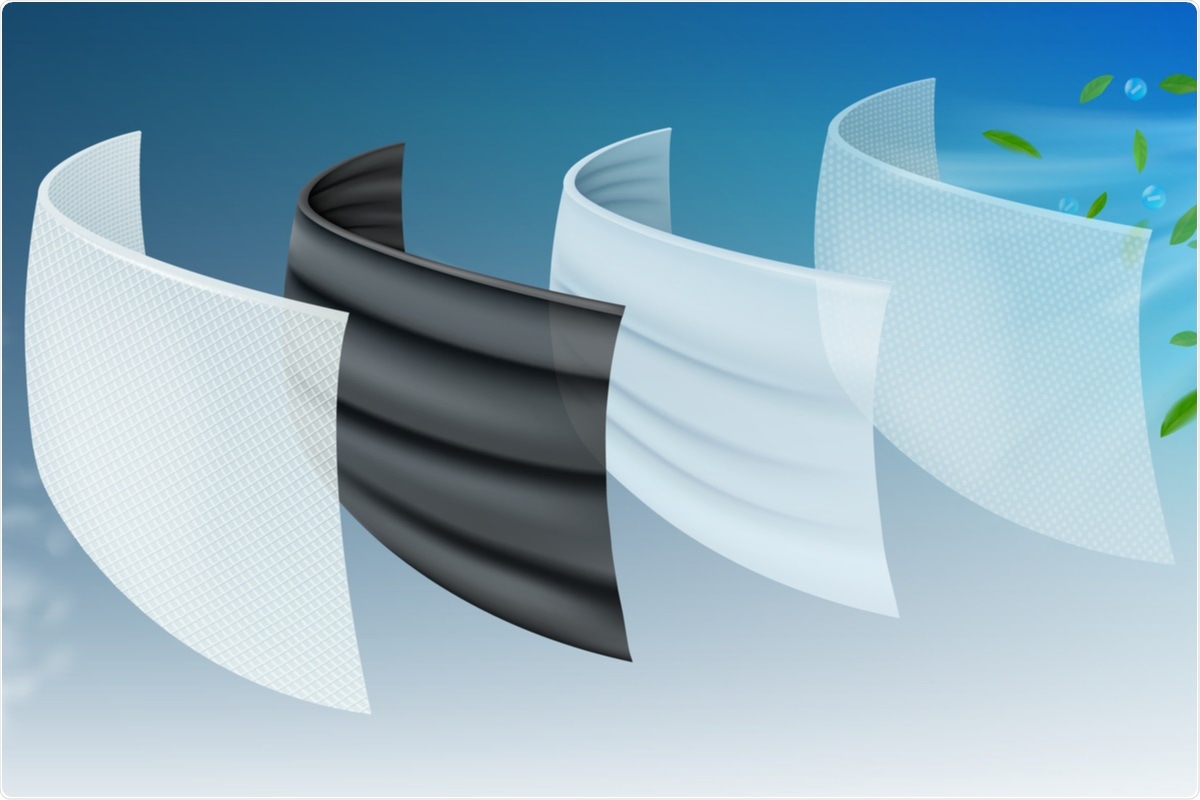In a latest Supplies As we speak Advances examine, researchers exhibit that Goldshield75 (GS75) coating inactivated the extreme acute respiratory syndrome coronavirus 2 (SARS-CoV-2) on N95 filters and masks.
Research: Efficient antiviral coatings for deactivating SARS-CoV-2 virus on N95 respirator masks or filters. Picture Credit score: VectorManZone / Shutterstock.com
Background
The coronavirus illness 2019 (COVID-19) pandemic has raised the need for private protecting tools, significantly filtering face masks like N95 masks. The usage of masks, vaccinations, and social distancing have efficiently diminished SARS-CoV-2 transmission. Though N95 respirator masks filter virus particles effectively, they can’t inactivate or kill the virus.
A number of methods, together with copper (Cu), silver (Ag), steel oxides, polymers, and benzalkonium chloride coatings on masks have been evaluated for his or her antiviral exercise. The key limitations of those approaches is that they brought on severe well being implications to the customers and surroundings. Thus, creating a secure antiviral coating that may be sprayed on or integrated into masks to deactivate the virus is essential for mitigating the SARS-CoV-2 pandemic.
In regards to the examine
Within the current examine, researchers evaluated the effectivity of the GS75 coating in inactivating SARS-CoV-2 on the surfaces of masks and different supplies. The crew decided whether or not GS75 may very well be a non-leaching and water-soluble anti-SARS-CoV-2 spray that confers persistent antiviral exercise to non-woven SP materials on the outer surfaces of N95 masks, N95 polypropylene filters/materials, and cotton fabric masks.
GS75 has a positively charged nitrogen atom in a quaternary ammonium group that lures microbes to the surfaces of filters or masks to which it’s certain. Furthermore, GS75 additionally has an extended alkyl chain that melts and disrupts the lipid layers discovered on the surfaces of microbes, inflicting the mobile contents to leak out and die. Thus, the antiviral properties of GS75 are primarily based on its electrochemical response and would doubtless impart sturdy and steady safety in opposition to SARS-CoV-2 and its future variants.
Within the present examine, the researchers sprayed GS75 on materials and masks utilizing a easy hand-held plastic spray bottle with a nozzle on two sides. Masks surfaces had been moist after the coatings and had been allowed to air dry.
Spray-coating was repeated two instances to acquire double-coated masks. The 2 SARS-CoV-2 variants used within the examine included the Beta and SARS-CoV-2 USAWA1/2020 strains.
Research findings
The SP materials that constituted the outer layer of the N95 masks uncovered to SARS-CoV-2 Alpha pressure, within the absence of GS75, generated appreciable Vero E6 cell cytopathic results (CPEs), thereby implying that this materials had a minimal influence on deactivating SARS-CoV-2. Nevertheless, double-coating GS75 within the SP materials demonstrated higher inactivation of the virus.
A whole absence of Vero E6 cell CPEs was evident in GS75 double-coated SP materials after six hours of viral publicity, thus suggesting the whole deactivation of the utilized SARS-CoV-2. In contrast, GS75 single-coated SP materials took 12 hours to inactivate the virus fully.
GS75 single-coated black cotton fabric masks exhibited incomplete inactivation of SARS-CoV-2 in two hours of publicity and full viral deactivation in six hours. In distinction, GS75 double-coated black fabric masks exhibited full viral inactivation inside 24 hours of publicity.
However, the degrees of viral deactivation had been decrease in two and 6 hours of viral publicity. As well as, these experiments didn’t embody an uncoated masks.
GS75 uncoated N95 masks exhibited a considerable decline in viral CPEs after 24 hours of publicity, whereas the GS75-coated N95 masks demonstrated full inactivation of SARS-CoV-2 following 24 hours publicity. Each uncoated and coated masks demonstrated a considerable lower in viral CPEs after six hours of viral publicity.
Comparable outcomes of SARS-CoV-2 inactivation had been noticed when GS75 coated masks and materials had been examined in opposition to SARS-CoV-2 Beta variant, thus demonstrating that the GS75 coating resulted in higher viral deactivation.
GS75 triple-coated Exxon, which is the inner filter of N95 masks, demonstrated full inactivation of SARS-CoV-2 following 24 hours of publicity. Nonetheless, within the absence of GS75 coating, Exxon exhibited vital viral CPEs.
GS75-coated supplies had been stored at 50°C for 2 days and examined in opposition to the inactivation capability of the SARS-CoV-2 USAWA1/2020 isolate. GS75 double-coated SP materials, N95 masks, and fabric masks preserved antiviral exercise. Microscopic examinations indicated that viral CPEs had been solely present in GS75-uncoated supplies.
After the continual addition of contemporary USAWA1/2020 isolates each day to the GS75 double-coated cotton masks, SP materials, and N95 masks, all retained antiviral exercise for 3 days. Comparable findings had been noticed following publicity to the SARS-CoV-2 Beta variant.
Cytotoxicity following GS75 addition was solely noticed in a double-coated fabric masks; nonetheless, an uncoated fabric masks was not evaluated parallelly. The noticed cytotoxic impact was doubtless as a result of materials or chemical of the masks, as no different GS75-coated supplies exhibited cytotoxicity.
Conclusions
The present examine described a possible methodology for safely deactivating SARS-CoV-2 on respirators and masks. Making use of the GS75 antimicrobial coating to masks and respirators made them acceptable for repeated use.
GS75-coated masks confirmed persistent inactivation of the SARS-CoV-2 Alpha and Beta variants for 3 days. Moreover, no indicators of decay in viral inactivation had been noticed when the coating masks had been stored at 50°C.
Taken collectively, the current examine demonstrated that the usage of GS75 for coating masks and materials will probably be useful in combating the continuing COVID-19 pandemic.

